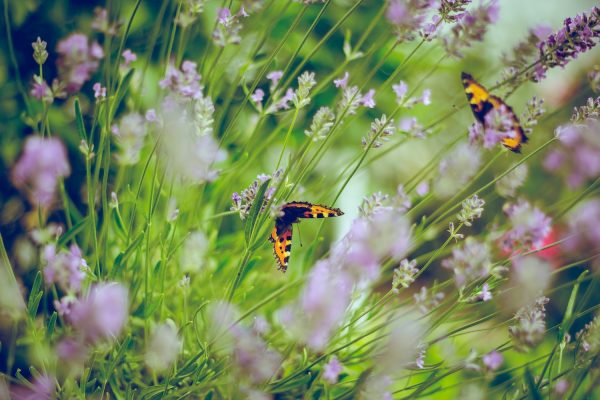With more than 7 million people participating across the country, the National Wildlife Federation’s Garden for Wildlife movement is the nation’s longest-running and largest effort dedicated to helping wildlife locally. The initiative reconnects our neighborhoods, towns, and cities back to the country’s amazing wild spaces by encouraging Americans to plant native plants – from wildflowers to trees – and to provide natural sources of food, water, cover, and places to raise young for wildlife in their backyards and communities. Celebrating 45 years this spring, Garden for Wildlife has grown to encompass more than 2.5 million acres of Certified Wildlife Habitat® backyards, gardens, fields, and community spaces across the United States that support and protect the future of wildlife including birds, bees, butterflies, and other amazing animals.
“Seeing wildlife in our yards is a great indicator of the health of the local environment. In fact, the ongoing health of our communities is directly linked to the health of the wildlife with which we share our backyards, towns, and cities. Quite literally, the air we breathe, the water we drink, and the food we eat, depends on healthy local wildlife and the natural spaces where they live,” said Mary Phillips, Senior Director of Garden for Wildlife, The National Wildlife Federation. “When you make simple changes to your outdoor spaces – from whole landscaped areas to a few planters – you are create stepping stones that help reconnect habitats for wildlife across the country.”

Anyone, at any age, anywhere can participate with almost immediate results – potentially doubling the numbers of diverse local wildlife– while increasing the benefits of having natural spaces within our communities, including reduced urban temperatures, reduced water runoff and pollution, and wonderful green spaces to provide a healing connection to nature.
There is a pressing need to help find a balance where people and wildlife coexist. People and wildlife are living in closer proximity to each other than ever before as metropolitan areas now consume nearly half of the lower 48 states. In fact, research shows that roughly two-thirds of all North American wildlife species inhabit metro areas. Experts say more than a third of North American wildlife species are at risk for extinction.
Programs with Impact
Garden for Wildlife programs are making an impact. Studies show wildlife habitat gardens support twice as much wildlife locally than traditional landscapes. Garden for Wildlife offers a range of options for anyone, anywhere, to help support local wildlife and to restore and reconnect America’s natural spaces. Garden for Wildlife includes the signature Certified Wildlife Habitat program, along with species-specific campaigns and partner initiatives, and the National Wildlife Federation State Affiliate and regional campaigns focused on birds and other wildlife. Specific opportunities to create and be recognized as a Certified Wildlife Habitat focus on where we, live, learn, play and worship including: Butterfly Heroes, Schoolyard Habitats, Eco Leaders Campus Wild, Sacred Grounds™ designation, Mayor’s Monarch Pledge, Community Wildlife Habitats, and the Million Pollinator Garden Challenge.
Currently 379 community leaders have taken the Mayor’s Monarch Pledge to increase monarch butterfly habitat through the efforts of 3 million people, and 170,000 people have taken the Butterfly Heroes pledge to create butterfly gardens with their families. The Million Pollinator Garden Challenge has established 700,000 pollinator gardens through joint efforts of the National Wildlife Federation and the National Pollinator Garden Network.
Resources
Garden for Wildlife programs provide easy to use tools and resources designed to help anyone take action for declining wildlife populations at www.nwf.org/garden. Highlights include:
- A monthly e-newsletter, downloadable tip sheets, blogs, and magazine articles covering common questions and information about species and habitat;
- Active social media communities on Facebook and Twitter;
- Books including Attracting Birds, Butterflies and Other Backyard Wildlife, by NWF naturalist, David Mizejewski and the new book Wildlife Gardening Tips for Four Seasons;
- A native plant finder that helps you compile a list of plants that occur and thrive naturally in your region to include in your wildlife garden;
- An online library of step-by-step videos and curriculum guides for educators that address every aspect of creating wildlife friendly spaces;
- Great accessories for any wildlife garden, from bird baths to bat houses; www.shopnwf.org/Garden-for-Wildlife/index.cat, and
- Informative and mobile friendly tools for registering your wildlife garden to be recognized under the Certified Wildlife Habitat® program; www.nwf.org/Home/Garden-for-Wildlife/Certify
Partners
The National Wildlife Federation amplifies the efforts of individuals and community groups through a range of national partnerships. 2018 Partners celebrating Garden for Wildlife’s 45th anniversary this spring, include: American Beauties Native Plants; GrowIt! and Botanical Interests, Inc. During its 45 years, Garden for Wildlife has worked closely with many key opinion leaders and experts committed to addressing critical decline of wildlife species, increasing sustainable resources and native plants in the garden marketplace, and advocating for practices that do not harm wildlife. For a full list of Garden for Wildlife partners and collaborators, please go to www.nwf.org/sitecore/content/Home/Garden-for-Wildlife/About/Program-Partners.

